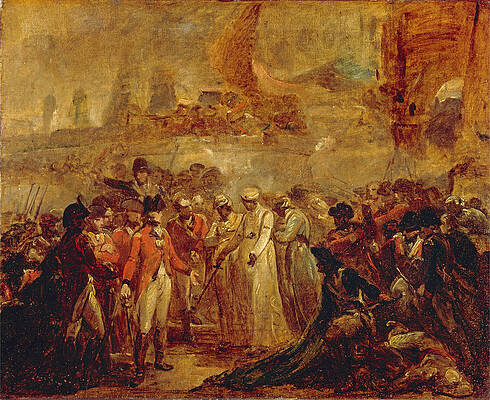Henry Singleton

The Surrender of the Two Sons of Tipu Sahib Sultan of Mysore to Sir David Baird
Falstaff at Herne's Oak
The Wandering Sailor



The Surrender of the Two Sons of Tipu Sahib, Sultan of Mysore, to Sir David Baird



Portrait of British Admiral Richard Howe

The Last Effort and Fall of Tippoo Sultan
Henry Singleton (19 October 1766 - 15 September 1839) was an English painter and miniaturist.
Family life
Henry Singleton was born in London, England, into an artistic family. He was not yet two years old when his father died, so he was raised by his uncle William Singleton (d. 1793), who had studied under the tutelage of Ozias Humphry and painted portraits and miniatures. Another uncle, Joseph Singleton, exhibited at the Royal Academy between 1773 and 1788. Henry’s sisters Maria and Sarah (later Macklarinan) were miniaturists who exhibited at the Royal Academy from 1808 to 1820 and from 1787 to 1806 respectively.
In 1807 Henry married his cousin William Singleton’s only daughter.
Henry Singleton died in London, at the house of a friend at 7 Kensington Gore, and was buried in the church of St Martin-in-the-Fields.
Work
Although Singleton, like his uncles and sister, also painted miniatures, he did not adhere strictly to the genre. He exhibited at the Royal Academy, between 1784 and 1839, approximately 300 works, a large proportion of which were portraits, with scriptural subjects making up much of the remainder. He was for many years the Royal Academy's oldest living exhibitor. His works were also exhibited at the British Institution from 1806 and at the Society of British Artists from 1824 until his death in 1839.
From the age of sixteen, Singleton worked as a professional portraitist. He attended the Royal Academy Schools from the age of seventeen and won the silver medal in 1784. His painting from John Dryden’s ode Alexander’s Feast won the gold medal in 1788. In 1793, Singleton was commissioned by the Royal Academy to paint a group portrait of forty of the academicians. Ironically, he never became a member or an associate of the Academy himself. Early in his career, Singleton was noted for large compositions from the Bible, Shakespeare or contemporary historical events. Although his portrait work was always in demand, he never achieved the great success as a historical painter that his early promise indicated. Lord Nelson, Admiral Vernon, Lord Howe and John "Mad Jack" Fuller are among his portrait sitters. Paul I Granting Liberty to Kościuszko (1797) and The Death of Captain Alexander Hood after Capturing the French 74 "L'Hercule", 21 April 1798 are considered by some to be his best works. Shortly before his death, Singleton completed a series of cabinet pictures to illustrate the works of Shakespeare.
Henry Singleton’s works are currently in the collections of the British Museum, the Victoria and Albert Museum, the National Portrait Gallery (London), the Scottish National Portrait Gallery, Tate Britain, the Ulster Museum, and the Brighton Art Gallery.
References
Foster, J. J. (Joshua James). A Dictionary of Painters of Miniatures (1525-1850): with some account of exhibitions, collections, sales, etc., pertaining to them (1926). Lenox Hill Publishing (Jun 1967). ISBN 0-8337-1218-7.
Harrington, Peter. British Artists and War: The Face of Battle in Paintings and Prints, 1700-1914,. Greenhill (1993). ISBN 1-85367-157-6.
Matthew, H. C. G. (Henry Colin Gray). Oxford Dictionary of National Biography: in association with the British Academy: from the earliest times to the year 2000. Oxford University Press, 2004. ISBN 0-19-861411-X.
----
Fine Art Prints | Greeting Cards | Phone Cases | Lifestyle | Face Masks | Men's , Women' Apparel | Home Decor | jigsaw puzzles | Notebooks | Tapestries | ...
----
Artist
A - B - C - D - E - F - G - H - I - J - K - L - M -
N - O - P - Q - R - S - T - U - V - W - X - Y - Z
Retrieved from "http://en.wikipedia.org/"
All text is available under the terms of the GNU Free Documentation License




